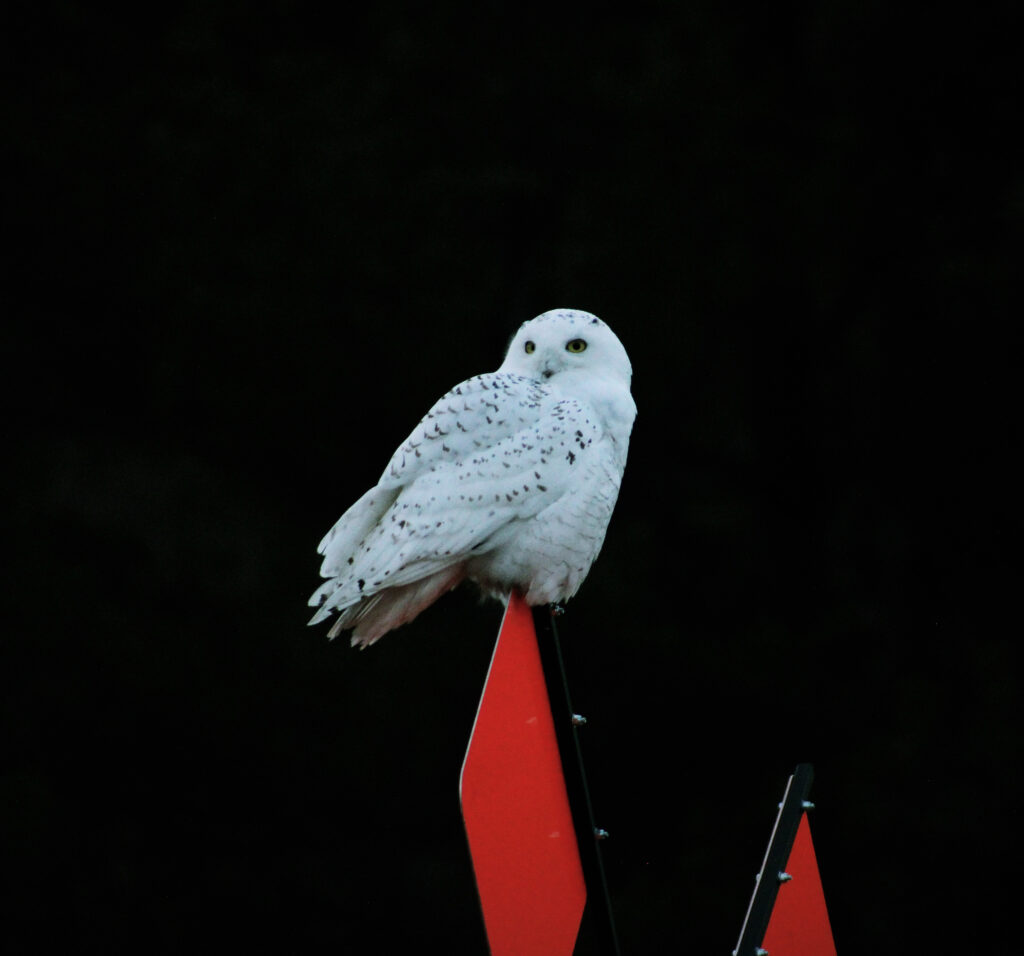
Birding Throughout Wisconsin
My name is Ryan Giordanelli, and I arrived at the Northwoods Wildlife Center in early February to start an internship here. As my last week here begins, I was asked to write about my many adventures around the state. Last year, I started birding as a hobby after seeing a lot of awesome species during fieldwork in California. As my first time visiting the state, I realized that Wisconsin has much to offer in the world of birding, even during the cold winter. I am a new but avid birder and have spent most of my free time exploring what winter birds the state has to offer. When I first came here, I made a list of the birds in the area that I wanted to see for the first time, and I was not disappointed. From new species of owls, winter songbirds, the largest species of gull in the world, to one of the most endangered species of bird in the world, I have added 31 new species to my growing life list. I could talk forever about the experience with each one, but I will focus on the highlights of species and the best places I have been, as well as include some of my favorite photos I took at each spot.
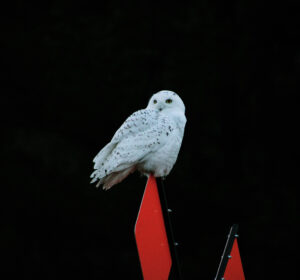
One species that was at the top of my list when I first arrived was the Snowy Owl. This owl can be found throughout Wisconsin during the winter, but it can be challenging to find. I was lucky enough to see one while driving on the roadside around dusk. The sighting was not only surprising for the area but also an excellent experience as I admired its beauty before letting it be for the night. These owls are known for hunting primarily lemmings but also whatever else they see or hear atop their perch. They only spend winter down from their breeding grounds in the Northern tundra of Canada. In some years, Snowy Owls can sometimes head farther South during the winter due to prey abundance. Habitat loss has become a significant problem for the species as the population has declined 64% since 1970. Seeing this beautiful species in person was a fantastic experience to start my quest to see the state’s winter birds.
The next adventure brought me one of, if not the rarest, birds I have seen yet. A very odd species appeared in northern Wisconsin in the city of Ashland. This species is called a Fieldfare and is related to the American Robin in the Thrush family. The Fieldfare is native to Eurasia, and there have only been around 10 confirmed sightings in the lower 48 states. To see this bird, I had to get to where it had been cited around 6 am. I, as well as around 30 other people, sat and waited for this bird for many hours with no luck at a sighting. Thankfully, this park had a lot of other remarkable species to offer. While waiting for the sun to rise, I was lucky enough to hear a pair of Great-horned Owls singing a beautiful duet to each other as they were most likely getting ready or already nesting. I saw Purple Finches, Trumpeter Swans, Bohemian Waxwings, and more northern species. It was a great place to look around and spend the day. The following week, I went back to give it a second shot. Again, there were around 20 people, and we all got to see and even hear it! Seeing a species so far out of its normal range was fascinating for everyone around. Meeting so many people from all around just to see this bird was a great experience. People drove 10+ hours just to get a glimpse of it. Hearing stories about other people’s adventures made it an exciting experience to be a part of.
Another new species for me came unexpectedly, but it was an excellent experience. I was driving back from photographing a Bohemian Waxwing as it sat in a tree to roost for the night when I saw a large bird fly into the trees from near the road. I decided to turn around and check it out, and it turned out to be a Barred Owl. I pulled off of the road, and at a reasonable distance away, I could admire the owl and get some great pictures. This goes to show that you can find wildlife anywhere you go, especially in the Northwoods! The Barred Owl is a medium-sized owl that, like most other owls, hunts for small mammals at night, but this species gets seen during the day more regularly than others. They give an iconic call at night that sounds like “Who-Cooks-For-You.” This species is also very interesting as it has done exceptionally well in recent years. It has spread west and is actually a significant factor in the decline of a very closely related species, the Spotted Owl, in the Pacific Northwest.

Talking about another species impacted by habitat loss, as well as a fun adventure and place to go birding, the Horicon National Wildlife Refuge was next on my list to hopefully catch a glimpse of the Whooping Crane. In 1967, the Whooping Crane dropped to less than 30 wild individuals. This was due to encroachment onto their wetland habitats, hunting, and egg collection. Many measures were taken to protect and bring back the population of the tallest bird in North America. The wild population is now over 650 individuals. This includes a migratory population that goes from Canada in the summer to Texas in the winter, an eastern migratory population, and two non-migratory populations in Florida and Louisiana. To get this population back, the International Crane Foundation had to collect and hatch eggs to ensure the health and care of the baby cranes. These cranes were carefully raised and then taught to migrate south during the winter. To teach them how to migrate, they had to be released during the fall near adult cranes that already knew how to migrate, or they were taught to follow a special aircraft South. The Horicon National Wildlife Refuge is one of the most extensive freshwater marshes in the United States, an ideal location for the Whooping Crane to be spotted. A breeding pair called the refuge home for multiple seasons, as well as a couple of recently released individuals. I saw a glimpse of one while walking around the trails in the refuge. Getting even a brief chance to see one of the rarest birds in the World was a fantastic experience. Not only did I get to see one of these cranes, but it is also a great spot to see so many other species just stopping by or ones that call the marsh their home. I got to hear and see the exciting American Woodcock for the first time, as well as see flocks of Rusty Blackbirds, Red-winged Blackbirds, Brown-headed Cowbirds, different sparrows, and hundreds of waterfowl across the marshy habitat. The wildlife refuge is a must-see for anyone visiting Wisconsin who enjoys seeing wildlife.
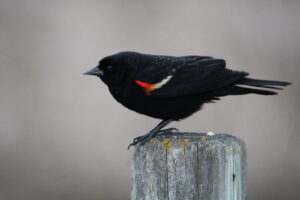
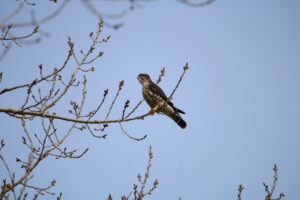
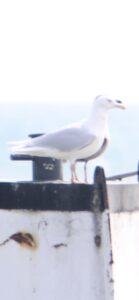
In addition to Horicon National Wildlife Refuge, there are many other spots I have visited to see a wide range of species. One of these was the cities of Sheboygan and Manitowoc along Lake Michigan. I saw many species while visiting these places, such as a Merlin, Great Black-backed Gull, Glaucous Gull, and many other species of ducks, grebes, and gulls. Watching the Merlin, a small falcon, made the trip well worth it. I got to see him feeding as well as hunting for more food. This species breeds primarily in the tundras of Canada and parts of the northern states while expanding its range farther south during winter months. They feed in a variety of habitats as well as on a variety of prey. The Great Black-backed Gull was one that I was searching for during my visit. It is the largest gull species in the World. Seeing a couple of them compared to the other gulls in the area was a site to see. These gulls are somewhat common winter visitors to the Great Lakes but are primarily an East Coast species. This is similar to the other new gull I was able to see while visiting, the Glaucous Gull. They also come to the Great Lakes for the winter but breed primarily in the northern tundras of Canada. This gull is also relatively large but much more pale than other gulls. The adult I got to see was easy to spot as it lacked the black wing tips that all the other gulls around had. Herring and Ring-billed gulls are the primary species seen, so it was nice to spot and admire these different species visiting the area.
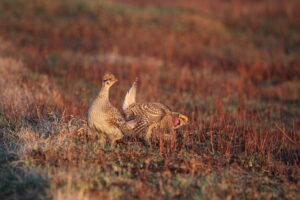
One of the last trips I could take before completing my internship was one of my favorites. I went to Crex Meadows State Wildlife Area in the west part of the state. This wildlife area has 30,000 acres of excellent habitat for over 250+ species of birds throughout the year. There are over 20 miles of roads to drive past different wetlands, plains, and lakes for these species. One of the most interesting year-round residents is the Sharp-tailed Grouse. Like many other grouse and prairie-chicken species, they have been affected by habitat loss. Crex Meadows provides habitat for these mesmerizing species to breed. In the mornings, the males come together to put on a show in hopes of breeding with a female. They get low to the ground, raise their tails, spread their wings, and stomp their feet to impress the females wandering around the area. In hopes of seeing this, I arrived at the area at 5 am, about an hour before sunset. After figuring out where to go I got to the lekking area right as the sun was rising. You can set up small blinds to give you the best chance to see them perform. I did not have a blind but stood quietly waiting for the show to start when I started to hear the foot-stomping of a performing male. Quickly, more and more males and females came within 20 feet of me as I watched in awe. How loud they were while displaying was so surprising to me. After watching for over an hour, I started to travel throughout the rest of the area. I saw 46 species in the area, my highest total in Wisconsin. The most surprising of these being a lone Snow Bunting. This species breeds in Northern Canada and comes down for the winter regularly, but that means that this individual should already be making its way back up as they commonly are one of the first species to leave when spring is around the corner. I am glad that I got a good look and pictures of this one before it hopefully goes back to Canada to breed.
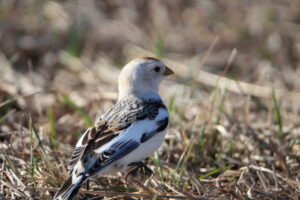
Thank you to the following sources for the information for this post:
https://storymaps.arcgis.com/stories/cde474fce6894560901fedf1ad2b9ade
https://www.audubon.org/field-guide/bird/barred-owl
https://www.audubon.org/field-guide/bird/merlin
https://www.audubon.org/field-guide/bird/great-black-backed-gull